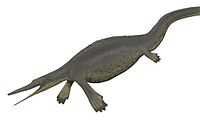Hupehsuchus
From Wikipedia, the free encyclopedia
| Hupehsuchus Temporal range: Early Triassic, Olenekian | |
|---|---|
 | |
| Hupehsuchus nanchangensis on display at the Paleozoological Museum of China | |
| Scientific classification | |
| Kingdom: | Animalia |
| Phylum: | Chordata |
| Class: | Reptilia |
| Order: | †Hupehsuchia |
| Family: | †Nanchangosauridae |
| Genus: | †Hupehsuchus Young, 1972 |
| Type species | |
| †Hupehsuchus nanchangensis Young, 1972 | |
Hupehsuchus is an extinct genus of small marine reptile, about 1 meter (3 ft) long. It was found in the area of Hubei in China. This marine reptile lived in the Olenekian stage of the Early Triassic period. Hupehsuchus was similar to its close cousin, Nanchangosaurus, but differed from it in a number of ways. For example, Hupehsuchus had heavier armor on its back than Nanchangosaurus, and its back spines were more finely divided, giving it a more crocodile-like appearance than Nanchangosaurus. It had a thin, long snout like a gharial, river dolphin, or ichthyosaur, which it probably used to snag fish or probe for aquatic invertebrates.

Life restoration of Hupehsuchus nanchangensis
Sources
- Chinese Fossil Vertebrates by Spencer G. Lucas
- The World Encyclopedia of Dinosaurs and Prehistoric Creatures by Dougal Dixon
This article is issued from Wikipedia. The text is available under the Creative Commons Attribution/Share Alike; additional terms may apply for the media files.